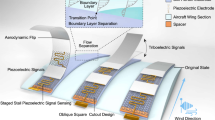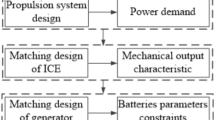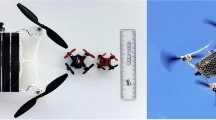Abstract
Since the first aeroplane flight more than 100 years ago, aeroplanes have been propelled using moving surfaces such as propellers and turbines. Most have been powered by fossil-fuel combustion. Electroaerodynamics, in which electrical forces accelerate ions in a fluid1,2, has been proposed as an alternative method of propelling aeroplanes—without moving parts, nearly silently and without combustion emissions3,4,5,6. However, no aeroplane with such a solid-state propulsion system has yet flown. Here we demonstrate that a solid-state propulsion system can sustain powered flight, by designing and flying an electroaerodynamically propelled heavier-than-air aeroplane. We flew a fixed-wing aeroplane with a five-metre wingspan ten times and showed that it achieved steady-level flight. All batteries and power systems, including a specifically developed ultralight high-voltage (40-kilovolt) power converter, were carried on-board. We show that conventionally accepted limitations in thrust-to-power ratio and thrust density4,6,7, which were previously thought to make electroaerodynamics unfeasible as a method of aeroplane propulsion, are surmountable. We provide a proof of concept for electroaerodynamic aeroplane propulsion, opening up possibilities for aircraft and aerodynamic devices that are quieter, mechanically simpler and do not emit combustion emissions.
This is a preview of subscription content, access via your institution
Access options
Access Nature and 54 other Nature Portfolio journals
Get Nature+, our best-value online-access subscription
$32.99 / 30 days
cancel any time
Subscribe to this journal
Receive 51 print issues and online access
$199.00 per year
only $3.90 per issue
Buy this article
- Purchase on SpringerLink
- Instant access to full article PDF
Prices may be subject to local taxes which are calculated during checkout




Similar content being viewed by others
Data availability
The data that support the findings of this study are available from the corresponding author upon reasonable request.
References
Chattock, A. P., Walker, W. E. & Dixon, E. H. IV. On the specific velocities of ions in the discharge from points. Phil. Mag. 1, 79–98 (1901).
Stuetzer, O. M. Ion-drag pumps. J. Appl. Phys. 31, 136–146 (1960).
Christenson, E. A. & Moller, P. S. Ion-neutral propulsion in atmospheric media. AIAA J. 5, 1768–1773 (1967).
Wilson, J., Perkins, H. D. & Thompson, W. K. An Investigation Of Ionic Wind Propulsion. Report No. NASA/TM 2009–215822 (NASA, 2009).
Masuyama, K. & Barrett, S. R. H. On the performance of electrohydrodynamic propulsion. Proc. R. Soc. A 469, 20120623 (2013).
Monrolin, N., Ploouraboué, F. & Praud, O. Electrohydrodynamic thrust for in-atmosphere propulsion. AIAA J. 55, 4296–4305 (2017).
Gilmore, C. K. & Barrett, S. R. H. Electrohydrodynamic thrust density using positive corona-induced ionic winds for in-atmosphere propulsion. Proc. R. Soc. A 471, 20140912 (2015).
Loeb, L. B. Electrical Coronas: Their Basic Physical Mechanisms (Univ. California Press, Berkeley, 1965).
Melcher, J. R. Traveling-wave induced electroconvection. Phys. Fluids 9, 1548 (1966).
Allen, P. H. G. & Karayiannis, T. G. Electrohydrodynamic enhancement of heat transfer and fluid flow. Heat Recovery Syst. 15, 389–423 (1995).
Drew, D. S., Lambert, N. O., Schindler, C. B. & Pister, K. S. J. Toward controlled flight of the ionocraft: a flying microrobot using electrohydrodynamic thrust with onboard sensing and no moving parts. IEEE Robotics Automation Lett. 3, 2807–2813 (2018).
Cumpsty, N. & Heyes, A. Jet Propulsion (Cambridge Univ. Press, Cambridge, 1998).
Leishman, J. G. Principles of Helicopter Aerodynamics (Cambridge Univ. Press, Cambridge, 2000).
Hoburg, W. & Abbeel, P. Geometric programming for aircraft design optimization. AIAA J. 52, 2414–2426 (2014).
Gu, W. J. & Liu, R. A study of volume and weight vs. frequency for high-frequency transformers. In Power Electronics Specialists Conf. 1123–1129 (IEEE, 1993).
He, Y., Woolston, M. R. & Perreault, D. J. Design and implementation of a lightweight high-voltage power converter for electro-aerodynamic propulsion. In IEEE Workshop on Control and Modeling for Power Electronics http://doi.org/10.1109/COMPEL.2017.8013315 (IEEE, 2017).
Hsu, W. C., Chen, J. F., Hsieh, Y. P. & Wu, Y. M. Design and steady-state analysis of parallel resonant DC–DC converter for high-voltage power generator. IEEE Trans. Power Electronics 32, 957–966 (2017).
McFarland, M. W. (ed.) The Papers of Wilbur and Orville Wright (McGraw-Hill, New York, 1953).
Acknowledgements
The work was also contributed to by many undergraduate students from 2010–2018 as part of MIT’s Undergraduate Research Opportunities Program (UROP), as part of MIT’s Minority Students Research Program (MSRP), or as part of MIT’s summer research exchange program with Imperial College London (IROP). These students include Y. K. Tey, P. Kandangwa, W. B. Rideout, J. Epps, S. O’Neill, M. Adams, J. M. Salinas, N. H. Rodman, I. L. LaJoie, W. A. Rutter, A. J. Sanders, N. J. Martorell, I. Vallina Garcia, J. P. Liguori, K. Dasadhikari, B. J. Scalzo Dees, M. H. Knowles, D. W. Fellows and D. P. Aaradhya. In addition, we thank A. Brown, T. Tao, C. Tan, P. Lozano, J. Peraire and C. Guerra-Garcia for technical discussions and advice, in some cases as part of student thesis committees. K. Masuyama, A. Dexter and J. Payton contributed to the project in its earlier phases. J. Leith and J. L. Freeman contributed to the financial and procurement administration for the project. F. Allroggen contributed to the resource management for the project. We also thank the laboratory staff at MIT AeroAstro for their help with the design, fabrication and flight testing of the EAD aircraft, in particular D. Robertson, T. Billings, A. Zolnik and T. Numan. Finally, we thank the MIT Department of Athletics, Physical Education, and Recreation for access to space for indoor flight testing, in particular S. Lett. This work was funded through MIT Lincoln Laboratory Autonomous Systems Line, the Professor Amar G. Bose Research Grant, and through the Singapore-MIT Alliance for Research and Technology (SMART). The work was also funded through the Charles Stark Draper and Leonardo career development chairs at MIT. This material is based on work supported by the Assistant Secretary of Defense for Research and Engineering under Air Force Contract No. FA8721-05-C-0002 and/or FA8702-15-D-0001. Any opinions, findings, conclusions or recommendations expressed in this material are those of the author(s) and do not necessarily reflect the views of the Assistant Secretary of Defense for Research and Engineering.
Reviewer information
Nature thanks D. Drew, K. Pister, F. Plouraboué and H. Smith for their contribution to the peer review of this work.
Author information
Authors and Affiliations
Contributions
S.R.H.B. conceived the aeroplane. H.X. and C.K.G. designed the aeroplane. Y.H., D.J.P. and M.R.W. developed the electrical power systems. H.X., Y.H., K.L.S., C.K.G., S.P.K. and C.C.H. built and tested the aeroplane. H.X. piloted the aeroplane. K.L.S. and S.P.K. performed wind tunnel tests. S.R.H.B., D.J.P. and T.S. coordinated the project.
Corresponding author
Ethics declarations
Competing interests
The authors declare no competing interests.
Additional information
Publisher’s note: Springer Nature remains neutral with regard to jurisdictional claims in published maps and institutional affiliations.
Extended data figures and tables
Extended Data Fig. 1 Schematic of propulsion system electrodes.
Not to scale. The emitting electrode is a 32 American Wire Gauge (32 AWG; 0.2 mm diameter) stainless steel wire, held at 60 mm spacing from the collecting electrode by 3D-printed spacers. The collecting electrode is a National Advisory Committee for Aeronautics (NACA) 0010 airfoiled foam section covered in a thin layer of aluminium foil. The electrodes are 3 m in span (into the page).
Extended Data Fig. 2 HVPC output voltage and input power for a single flight (number 9).
The HVPC is designed to ramp up to the final voltage over 20 s while the aeroplane is on the launcher. The aircraft was in flight for 10–12 s. During flight, the HVPC regulates the output voltage to maintain 40.3 kV.
Supplementary information
Supplementary Video 1
Undistorted camera footage from flight 9, with position and energy from camera tracking annotated.
Supplementary Video 2
Undistorted camera footage from unpowered glide 2, with position and energy from camera tracking annotated.
Rights and permissions
About this article
Cite this article
Xu, H., He, Y., Strobel, K.L. et al. Flight of an aeroplane with solid-state propulsion. Nature 563, 532–535 (2018). https://doi.org/10.1038/s41586-018-0707-9
Received:
Accepted:
Published:
Issue date:
DOI: https://doi.org/10.1038/s41586-018-0707-9
Keywords
This article is cited by
-
Organic photovoltaic mini-module providing more than 5000 V for energy autonomy of dielectric elastomer actuators
Nature Communications (2025)
-
Sawtooth multi-ring electrodes for ionic wind propulsion
Scientific Reports (2025)
-
Electrostatic field-enabled ultra-efficient evaporative cooling
Nature Communications (2025)
-
Effect of the high voltage waveform on the ionic wind produced by a needle-to-plate dielectric barrier discharge
Scientific Reports (2022)
-
Toroidal counter electrode for ionic propulsion
Scientific Reports (2022)




Jayarava
Years ago I built a "jacob's ladder" from a 15kV neon sign transformer and two metal rods (same principle of ionising air). In an enclosed room the air became almost unbreathable in about 2 minutes of operation. I assume it was mostly because of ozone reacting with the water in my lungs. Now I wonder if it was also nitrogen oxides.
My question is, what are the emissions from this method of propulsion? Isn't a stream of ionised air going to leave a trail of ozone and nitrogen oxides?
A model glider is one thing, but what about when it is scaled up to carry cargo or people? If it going to be a major polluter, then they ought to stop now.
Ethan Krauss Replied to Jayarava
The truth is that O2 molecules in the air can easily absorb > trillions of electrons from a really fine negative emitter wire, in the range of several microns. If the voltage and current are kept within specific parameters, very high and low, respectively, then only harmless negative ions will be produced. In order to implement this in practice, requires specific electrical and geometric arrangements for the emitter, collector, and electrical systems. This mode of operation is much more efficient and does not produce any O3 or nitrogen oxides. Please see my patent number US 10,119,527. Thanks!
Thomas F. Valone
This Nature article replicates but does not acknowledge the T. Townsend Brown design for a 1950s electrokinetic wing propulsion from 40+ kV high voltage using ion wind or corona discharge. Furthermore, the same geometry seen in the Figure 1 diagram, with positive wire charge electrode separated and out in front of the negatively charged wing, was used by Brown in his #3,018,394 US patent https://patents.google.com/... and others filed in 1957 after five years of work for General Electric on corona discharge style of electric aircraft propulsion. The authors have a nice video demo showing their light aircraft flying under electric propulsion but Brown showed the military a better demo in 1952 which became a published report https://www.amazon.com/Elec... with a merry-go-round design of heavier aircraft that is also featured in his US patent #2,949,550 https://patents.google.com/... using a few hundred kilovolts. Brown was also responsible for starting an international electrogravitics movement in the 1960s with all of the aeronautics companies around the world and two major reports published by the Aviation Studies Ltd. In 1956, as documented in my edited books and reports on the research and development ( https://www.integrityresear... of the Biefeld-Brown Effect (also on Amazon). This reviewer believes that if we don’t learn from history, we are bound to repeat it.
Ethan Krauss
This MIT Solid-State Propulsion Aircraft, is not the first flight of such a system with the power supply onboard. The "Self Contained Ion Powered Aircraft," US Patent number 10,119,527, has a >> power to weight ratio, and overall efficiency level. It has been published by the US Patent Office. Case Western Reserve University (OH), Physics.org, Stardust Startup Factory, and will be soon released in the Cleveland State University, as well as Oberlin College media. Please type in Google Search Engine to see videos. Thanks!
Ethan Krauss
I would like to respectfully request that you withdraw the above paper entitled "Flight of an aeroplane with solid-state propulsion." The article states that no heavier than air ion propelled aircraft has flown with its power supply onboard ever before theirs. My patented "Self Contained Ion Propelled Aircraft" did, and is much more powerful by weight. There are many other errors in the MIT paper, but enough is enough.